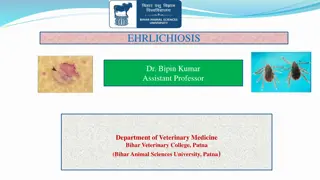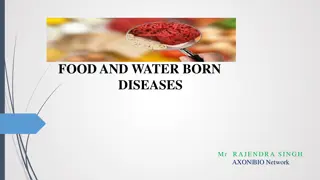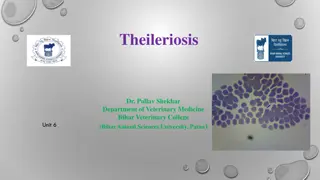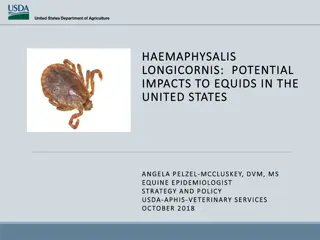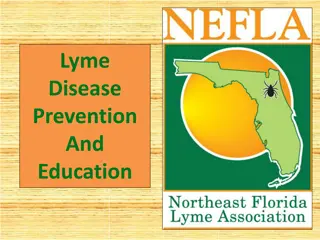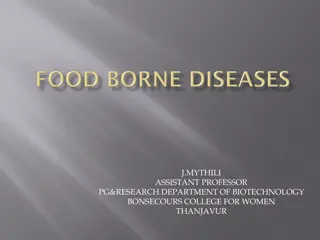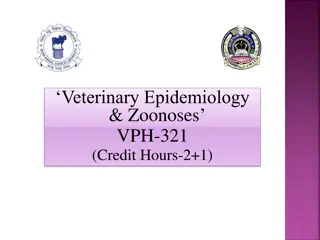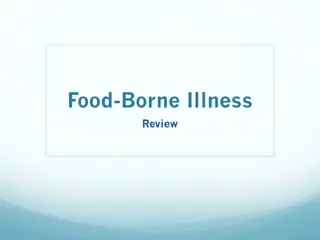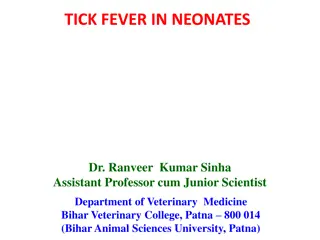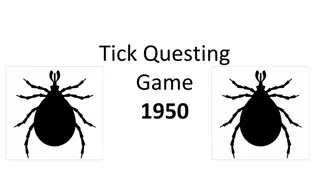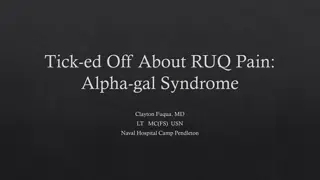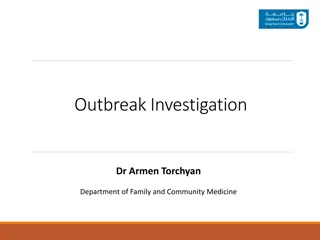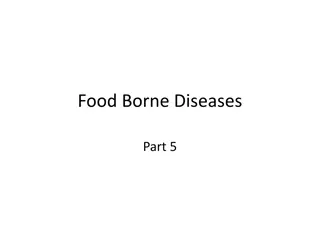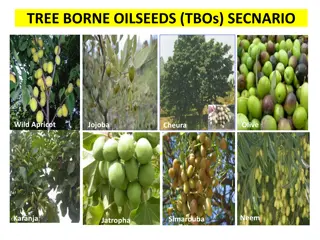A Student Exploration of the Global Impacts of Climate Change on Human Health
This research delves into the effects of climate change on human health, covering how a warming climate, changes in precipitation, and increased flooding frequencies impact various health aspects such as infectious diseases, nutrition, and mental health. The study provides a visual model illustratin
5 views • 17 slides
Understanding the Natural History of Disease Development and Prevention
The natural history of disease development outlines the progression of a disease in an individual without intervention, from exposure to outcome. Learning objectives include defining prevention terms, understanding disease severity, prevention levels, and intervention measures. Studying disease prog
4 views • 16 slides
Flea and Tick Products Market: Industry Analysis and Forecast 2032
The global flea and tick products market size was valued at USD 6.20 Billion in 2022 and is likely to reach USD 13.83 Billion by 2031, expanding at a CAGR of 9.32% during 2023 \u2013 2031.
2 views • 4 slides
Principles of Epidemiology: Understanding Disease Occurrence and Surveillance
Epidemiology is the study of disease patterns, factors influencing disease occurrence, and the core functions of surveillance, field investigation, and analytic studies. It involves understanding disease characteristics, natural history, and evaluating the effectiveness of activities to mitigate dis
1 views • 25 slides
Understanding Canine Monocytic Ehrlichiosis: Symptoms, Phases, and Treatment
Canine Monocytic Ehrlichiosis is a tick-borne disease caused by Erhlichia species, primarily affecting dogs. This article covers the pathogenesis, clinical findings in different phases (acute, subclinical, and chronic), and associated symptoms. Learn about the transmission, distribution, and potenti
0 views • 11 slides
Understanding Food and Water-Borne Diseases: Causes and Classification
Food and water-borne diseases, caused by contaminated food or water, lead to acute illnesses. These diseases are classified into food-borne infections and food-borne intoxications. Food-borne infections, triggered by pathogenic microorganisms, can be fungal, bacterial, viral, or parasitic, with long
3 views • 57 slides
Understanding Ephemeral Fever/Three-Day Sickness in Cattle and Water Buffalo
Ephemeral fever (Three-Day Sickness) is an acute arthropod-borne viral disease affecting cattle and water buffalo. It is caused by the Bovine Ephemeral Fever Virus and manifests with biphasic fever, decreased milk yield, and other clinical signs. The disease has varying prevalence and can lead to hi
0 views • 7 slides
Insights into Tyzzer's Disease: An Overview of a Bacterial Infection in Laboratory Animals
Tyzzer's disease is an acute bacterial infection affecting rodents and rabbits, caused by Clostridium piliforme. Discovered in 1917 by Ernest Tyzzer, the disease is characterized by necrotic lesions in the caecal mucosa, liver, and heart. Initially known as Bacillus piliformis, it was later renamed
2 views • 21 slides
Understanding Disease Control and Prevention in Epidemiology
This article discusses disease control processes in epidemiology, including reducing disease incidence, duration, and transmission. It covers public policy interventions, elimination, eradication, and extinction of infectious agents. It also highlights preventable causes of disease and different lev
2 views • 10 slides
Understanding Water-borne Diseases and Pathogens
Drinking contaminated water can lead to water-borne diseases, causing millions of deaths annually, especially in developing countries. Potable water is essential for health and development, as water-related diseases arise from inadequate water quality and poor sanitation practices. Various pathogens
1 views • 28 slides
Understanding Bovine Theileriosis: Causes, Symptoms, and Prevention
Bovine theileriosis is a tick-borne haemoprotozoan disease that causes significant economic losses in livestock due to high mortality rates, weight loss, abortion, and reduced milk yield. The disease is characterized by fever, anemia, and respiratory and digestive disorders. It is caused by parasite
1 views • 11 slides
Understanding Bovine Ephemeral Fever: Key Information and Insights
Bovine Ephemeral Fever, also known as Three-Day Sickness or Three-Day Fever, is an economically important arboviral disease affecting cattle and water buffalo in tropical and semitropical regions. It is caused by an arthropod-borne rhabdovirus and primarily transmitted by mosquitoes and biting midge
0 views • 19 slides
Potential Impacts of Haemaphysalis longicornis on Equids in the United States
Haemaphysalis longicornis, an Asian longhorned tick, poses potential threats to equids in the United States. Originally from Northeast Asia, this tick has been detected in the U.S. and has a wide range of hosts, including cattle, sheep, dogs, humans, and various wildlife. Its parthenogenic reproduct
0 views • 14 slides
Screening for Peripheral Vascular Disease in Patients with Coronary Artery Disease
Patients with coronary artery disease should be screened for peripheral vascular disease as it is a frequent integrator of global cardiovascular risk. The association of atherosclerosis in various arterial diseases highlights the importance of identifying multisite artery disease. The prevalence and
0 views • 23 slides
Human Disease Symptom Network: Understanding Disease Relationships Through Symptoms and Genes
The Human Disease Symptom Network (HSDN) is constructed using a large-scale medical bibliographic records database to form a network of human diseases based on symptom similarities. By integrating disease-gene associations and protein-protein interaction data, correlations between symptom similarity
0 views • 37 slides
Comprehensive Guide to Lyme Disease: Prevention, Transmission, Symptoms, and Treatment
Lyme disease, caused by the Borrelia burgdorferi bacterium transmitted through tick bites, can lead to various symptoms if left untreated. Learn about prevention methods, how to handle tick bites, recognize symptoms, and understand the challenges in testing and treating acute and chronic Lyme diseas
0 views • 14 slides
Food Safety and Prevention of Food-borne Illnesses
An estimated 48 million Americans suffer from food-borne illnesses yearly, caused by harmful microorganisms due to poor food handling practices. Factors contributing to food-borne illnesses include improper cooking, inadequate storage, and cross-contamination. To prevent such illnesses, it is essent
0 views • 23 slides
Understanding One Health Approach for Food Security and Public Health
The concept of One Health emphasizes the interconnectedness of human, animal, and environmental health. This approach explores how animal-borne illnesses impact food security, public health, and overall well-being. By examining diseases like avian influenza, Newcastle disease, and brucellosis, we se
0 views • 15 slides
Food Safety and Preventing Food-borne Illness
This lesson focuses on the importance of food safety, addressing how clean our food is and at what points safety can be compromised. It delves into common types of microbes that contaminate foods and explores ways in which food safety can be compromised. The activity involves case studies on food sa
0 views • 11 slides
Understanding Bacterial Diseases of Fish: Columnaris Disease Overview
Columnaris disease, also known as Saddleback disease, is a common bacterial infection in fish that is often brought about by poor handling and high stress levels. This disease manifests as tail and fin rot, leading to rapid fish mortality. The causative organism, Cytophaga (formerly Flexibacter), is
0 views • 21 slides
Understanding Lyme Disease: Symptoms, Diagnosis, and Treatment Options
Lyme disease is an infectious inflammatory disease caused by Borrelia burgdorferi and spread by tick bites. It presents with a range of symptoms, including fever, headache, fatigue, and a characteristic erythema migrans rash. Prompt diagnosis and treatment are essential to prevent complications such
0 views • 16 slides
Understanding Food-Borne Diseases: Causes, Symptoms, and Prevention
Food-borne diseases are caused by the ingestion of contaminated food containing microorganisms or chemicals. There are two types of food infections - contaminated food acting as a carrier of microorganisms and food serving as a culture medium for pathogens. Bacteria, viruses, and parasites are commo
0 views • 20 slides
National Vector Borne Disease Control Program Overview
The National Vector Borne Disease Control Program (NVBDCP) focuses on preventing and controlling diseases such as Malaria, Dengue, Chikungunya, Filariasis, Japanese Encephalitis, and Kala-azar. Implemented at state level, NVBDCP aims to eliminate these diseases through strategic planning, policy mak
0 views • 9 slides
Understanding Kyasanur Forest Disease: A Veterinary Perspective
Kyasanur Forest Disease (KFD) is a tick-borne viral hemorrhagic fever caused by the Flavivirus, primarily affecting monkeys and humans in certain endemic areas of India. The disease was first identified in 1957 in Karnataka and is characterized by symptoms like fever and bleeding disorders. The viru
0 views • 16 slides
Decoding Genetics: Insights from Alzheimer's Disease Symposium to Type 2 Diabetes Study
Explore the latest findings from the Alzheimer's Disease Genetics Symposium 2019 on disease mechanisms, drug targets, and genetic pathways. Dive into the progress made by the Alzheimer's Disease Genetics Consortium over the past decade. Transition to a Genome-Wide Association Study uncovering suscep
0 views • 42 slides
Food Safety Review: Preventing Food-Borne Illness
Explore key aspects of food safety including the definition and symptoms of food-borne illnesses, categories of causes, common pathogens like Salmonella and E. coli, personal hygiene practices, proper food storage techniques, and thawing methods. Gain insights into preventing food-borne illnesses th
0 views • 11 slides
Spatial Epidemiology of Tick-Borne Diseases in Kansas
Explore the spatial epidemiology of tick-borne diseases in Kansas through data analysis and design of informative materials. Help the Kansas Department of Health and Environment by analyzing tick-borne disease data, calculating cases over the years, and creating graphs to visualize important trends.
0 views • 8 slides
Understanding Tick Fever in Neonates: Symptoms, Diagnosis, Treatment, and Prevention
Tick fever in neonates is a febrile disease transmitted by tick bites, with symptoms including fever, loss of appetite, depression, weakness, red urine, anemia, and jaundice. The disease can be diagnosed through clinical symptoms, tick presence, and blood smear examination. Treatment involves medica
0 views • 9 slides
Tick Questing Game 1950 - Fun Temperature-based Card Game
Tick Questing Game 1950 is an exciting card game where players draw cards based on temperature conditions. The game involves questing ticks, recording sheets, and bonuses for successful quests. Players must strategize based on temperature ranges to keep their ticks alive and compete with their partn
0 views • 108 slides
Understanding Lyme Disease: Risks, Symptoms, and Prevention
Tick-borne diseases, particularly Lyme Disease, pose a significant health concern in the United States. Learn about the various diseases transmitted by infected ticks, the rise in Lyme Disease cases, who is at risk, and the symptoms to watch out for. Discover the basics of Lyme Disease, including it
0 views • 44 slides
Understanding Alpha-Gal Syndrome: A Comprehensive Overview
Alpha-gal syndrome (AGS) is a unique allergy triggered by the Lone Star tick in the US, leading to sensitization to alpha-gal. This presentation covers the cause, symptoms, diagnosis, and treatment of AGS, alongside the overlap with US military installations. Explore the clinical manifestations, geo
0 views • 17 slides
Liver Disease Burden in Tower Hamlets
Dr. Somen Banerjee, Director of Public Health in London Borough Tower Hamlets, highlights the concerning liver disease mortality rates in the area, with high incidence of cirrhosis, cancer, and hepatitis B and C. The data reveals a significant burden of liver diseases such as Non-Alcoholic Fatty Liv
0 views • 18 slides
Outbreak Investigation and Management in Public Health
Outbreak investigation is crucial in understanding, distinguishing, and managing disease outbreaks. This involves identifying the nature of outbreaks, studying key terms like endemic and epidemic, and examining outbreak settings such as food-borne and water-borne scenarios. By investigating outbreak
0 views • 53 slides
Leveraging NASA EOS Data for Water-Related Disease Research and Response
Explore how NASA EOS data is crucial in understanding and addressing vector-borne and water-related diseases, such as malaria outbreaks. Through satellite observations, a deeper insight is gained into natural hazards' impact on public health and ecology, aiding in disaster preparedness and disease t
0 views • 6 slides
Understanding Inflammatory Bowel Disease: Crohn's Disease and Ulcerative Colitis
Inflammatory Bowel Disease (IBD) encompasses Crohn's disease (CD) and ulcerative colitis (UC), chronic conditions with immunologic basis. This article delves into the epidemiology, pathophysiology, and differences between CD and UC, highlighting clinical features, pathology, and complications like a
0 views • 42 slides
Understanding Fungal and Chemical Food-Borne Intoxications
Fungal intoxications are caused by mycotoxins produced by fungi in improperly stored food, with aflatoxicosis being a significant concern. Aflatoxins can lead to acute hemorrhagic syndromes and long-term liver tumors. Prevention strategies include proper drying and storage of foods. Chemical food-bo
0 views • 19 slides
Tree Borne Oilseeds (TBOs) Scenario and Promotion Overview
This document provides insights into the Tree Borne Oilseeds (TBOs) scenario including a list of oilseeds like Neem, Karanja, and Jatropha, states covered, distribution, and uses of various TBOs. It also discusses the introduction of TBOs, their botanical names, oil/fat percentages, and utilization.
0 views • 12 slides
Ultrastructural Alterations of Renal Tissue in a Male Patient with Fabry's Disease
Fabry's disease is a rare X-linked lipid storage disorder characterized by deficient lysosomal alpha-galactosidase A activity. This condition primarily affects males, leading to chronic kidney disease and progression to end-stage renal disease. Kidney involvement is a critical aspect, and high doses
0 views • 24 slides
Remembering Jonathan Larson: Musical Theater Visionary
Jonathan Larson, the brilliant musical theater songwriter and librettist known for Rent and Tick, Tick...BOOM!, left a lasting impact on Broadway before his untimely death in 1996. Through his work, he explored social issues like multiculturalism, addiction, and homophobia, aiming to bring meaningfu
0 views • 7 slides
Lyme Disease Awareness and Prevention Training
Learn about Lyme disease spread by blacklegged ticks, tick life cycle stages, and how to avoid tick bites. Discover tips for checking and removing ticks effectively to prevent infection. Stay informed and take necessary precautions to reduce the risk of Lyme disease transmission.
0 views • 10 slides




